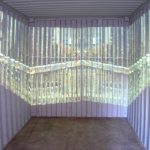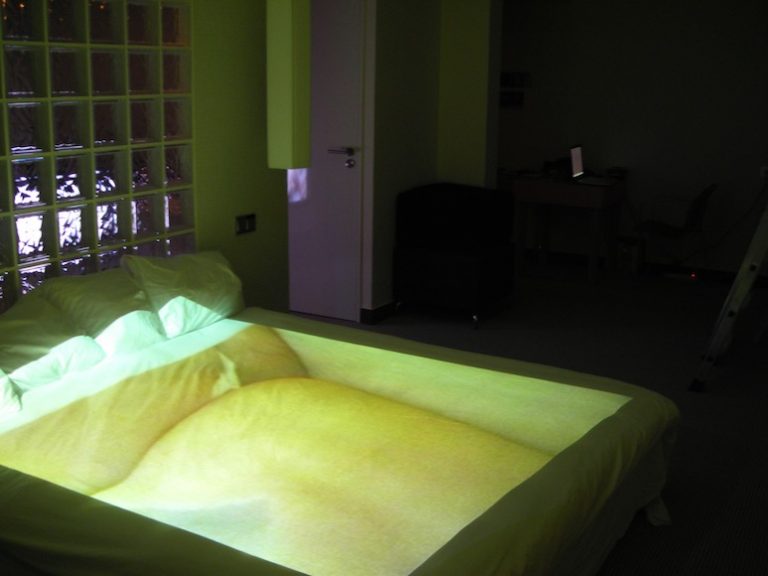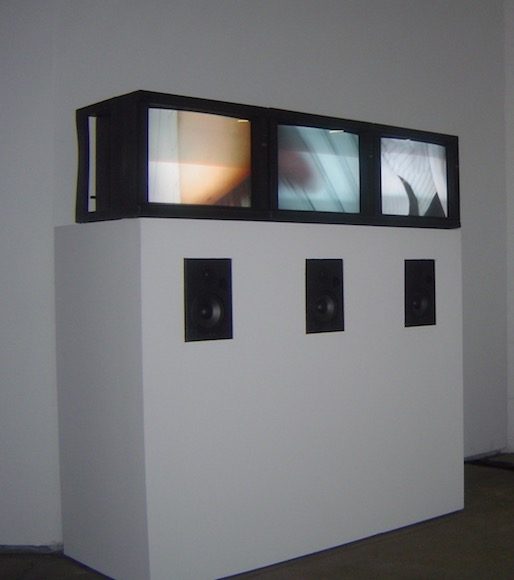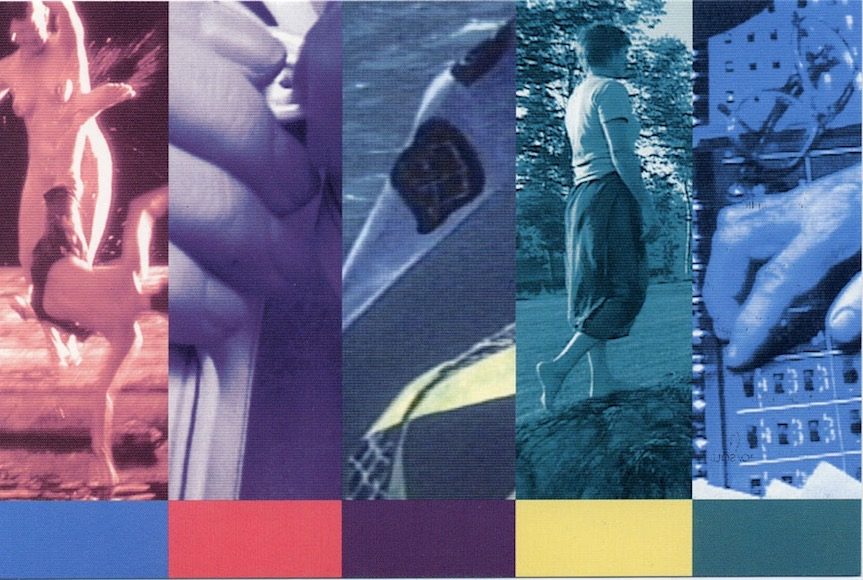"Redefining the ordinary", January 18 -24, 2006, Vol. 75 No. 35

Villager photo by Jefferson Siegel
Film and video artist Molly Davies
The Villager
Redefining the ordinary
By Nicole Davis
At first glance, the group of crates, piled haphazardly in a corner of this Chelsea gallery, looks nothing like the rest of the work on view at Molly Davies’ first New York retrospective of her forty-year career. She is, after all, a film and video artist, so stumbling upon these Chinese produce crates, which house illuminated scenes from parks in Paris and Berlin, and emit, from some speaker somewhere, a chorus of tree frogs, seems like a curatorial mistake. In fact, the installation, titled “Dislocation,” may be the most symbolic of Davies’s signature style — changing the meaning of the most ordinary things through some savvy repackaging.
Five video installations over three decades show the many sides of this meditative video artist, who says she often films first, and decides on the structure later. One of the least visually arresting works in the show, “David Tudor’s Ocean,” has perhaps the best back-story. Its inspiration sprang from a conversation with Nam Jun Paik, commonly called the godfather of video art. He told Davies she should make a documentary of David Tudor, a friend and avant garde musician for whom John Cage created piano and electronic compositions.
“But I don’t do documentaries,” Davies explained.
“Just shoot his hands,” Paik told her.
So she did. She filmed hours and hours of footage of Tudor setting up and creating the music for a Merce Cunningham dance performance that Tudor, then the company’s music director, scored with a half-finished composition by Cage called “Ocean.”
“I shot it in 1984 — and as always, it took three years for me to figure out what to do with it,” says Davies. She ultimately decided to split the footage between the slow, methodical act of preparation and the seamless, seemingly effortless process of performance. Three of the six screens in the installation show Tudor setting up for the 90-minute show — one for each day of set up. Every so often one of these screens flashes, which signals where the film was cut. On the other three screens — one for each day of the performance — there are no edits, and hence no flashes, only a continuous loop of Tudor as he plays (or programs) the electronic music from the pit while the dancers move on stage.
“It’s a portrait of the working process through detail and accumulation,” says Davies, a statement that applies just as well to her collected body of video art. In “Sea Tails,” for instance, we see her collaborative style at work. “I almost always work with friends and family,” says Davies, who fortunately knows some very talented people. Filmed over a week in the Bahamas, it brings together the underwater kites created by friend and artist Jackie Matisse and the music of David Tudor, who stayed on board and recorded the marine sounds while Davies filmed the billowy, colorful movement underwater. There is a method at work in the finished product: At all times, a pair of screens — there are three pairs, or six screens, altogether — displays the kite’s movement in unison as three different speakers play a different Tudor composition simultaneously. That may be much to grasp on paper, but in person it gels beautifully as the kites flow like seaweed to the sound of the snaps and cracks beneath the aquamarine water.
This multi-layered approach is echoed in “Dressing,” where we see her partner of 16 years, dancer Polly Motley, performing the simple act we repeat each morning, on three different screens. “It’s basically just putting appendages through holes,” says Davies, but through her multi-monitor-lens, as we watch Motley slowly button her shirt and zip her slacks, this quotidian chore becomes sensual, even erotic.
Davies, who has lived in her loft at Broadway and Great Jones for the past 20 years, began making films in the late 60s to document her friends and family.
“I was hanging out with the great documentary makers” — the ones responsible for bringing cinéma vérité to the New World — “DA Pennebaker and Richard Leacock, and I was so struck by their ability to get those everyday moments.” She continued making films and teaching when she moved to St. Paul with then-husband, conductor Dennis Russell Davies. There, she met dancer Sage Cowles, and began what would become a ten-year collaboration on performance pieces that featured multiple screen projections of Cowles while she performed on stage. (Last spring, for Cowles’s 80th birthday, they reconstructed their seven-piece oeuvre at Dance Theater Workshop and the Walker Art Center in Minneapolis.) Davies says she ultimately embraced video installations because it freed her from the constraints of live performance. “I wanted the time to construct something in the way I wanted to construct it,” she says.
When Davies returned to New York in 1984, she also took time to raise her life’s other important work: her children, three from her marriage, along with two of Polly’s. It is one reason she did not stay in the forefront of video art like a contemporary of hers, Bill Viola, who is actually a few years her junior. “It’s a crucial time — between 40 and 50, if you’re not out there in New York, you kind of drift off the map. I’m probably better known with the dancers,” says Davies, who, despite her 62 years and two grandkids, sports a spiky haircut and stylish threads that make her one very hip grandmother, with plenty of fire left.
It shows in the other work on view, like “Desire,” in which a playful conversation among friends takes on sexual undertones, and in “Pastime,” a multi-layered work that turns a simple summer afternoon of play with mother and son into something downright Oedipal.
“I shot it because of the absolutely riveting beauty of the afternoon light,” she said, unaware of how provocative the scene was at first. But somewhere deep down she picks up on these intimate undercurrents that run through the most innocent of scenes.
“You don’t always see the significance of these moments initially. But then you go home, and go into the studio, and it reveals itself to you.”
Related:
Categories: news
Tags: Molly Davies




